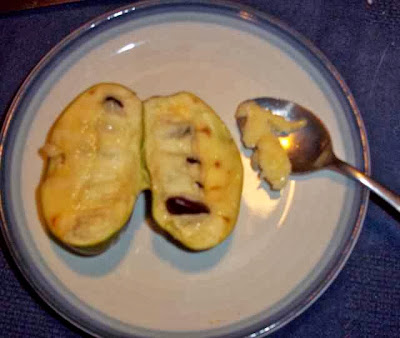Picking Up PawPaws
The pawpaw harvest at Polecat Creek Farm both commenced and ended today. I didn't think I'd be able to get to them this year, but John drove me down to the bottoms in the '71 Ford truck so I didn't have to walk so far. Luckily, he'd bush-hogged the bottoms the day before, so I getting to the trees was a lot easier than I thought it would be. The pawpaw trees are on the other side of this field:
To get there, we passed a creepy sight—a skeleton in the woods. A deer skeleton, that is.
And we passed this creepy tree along the creek. Part of it looks like an animal face.
Just past the tree, I spotted the first pawpaw. The pawpaw is a fruit native to America, but it's only available for a short time. It doesn't travel well or last long, so you aren't likely to see it in stores.
The line of pawpaw trees is to the right of this field.
Soon a few more pawpaws came into view.
Some were on the ground and showed signs of being gnawed on by critters. Pawpaws have a wonderful taste—a little like a banana-mango combination.
Farther along the creek were a few more pawpaws. They were hard to spot among the leaves unless we looked closely.
We could reach some, but John had to shake the tree to get the ones on the higher branches. The pawpaws were ripe, so they fell easily. We probably did more picking up than actual picking.
Before long, I had a bag full—the entire harvest on this side of the creek.
We crossed Polecat Creek to see if there were pawpaws on the east side.
We found more signs that critters had been nibbling.
The pawpaw trees are at the end of this field on the left.
Yep, there were a few.
After some more tree-shaking, we managed to get another bag full from this side.
The pawpaws this year were actually fairly small, but we got lots more than we did last year.
Pawpaws, which only stay fresh for a few days after picking—or picking up—have a wonderful aroma and flavor.
To eat, you cut one open to reveal the creamy inside and the seeds . . .
You can scoop the custardy inside out with a spoon or just slurp it up.
Before long, only the skins and seeds are left.
To learn about pawpaws, check out the Kentucky State University "Pawpaw Description and Nutritional Information" website or the KSU pawpaw page.
~
Labels: pawpaw, rural life























2 Comments:
I have not had a paw paw since I was a child. I am not aware of any paw paw trees on our farm, but there used to be a few on my father's place. He cut them down, I think, long ago.
I can remember paw paws from when I was small, but I haven't seen one in years.
Post a Comment
<< Home